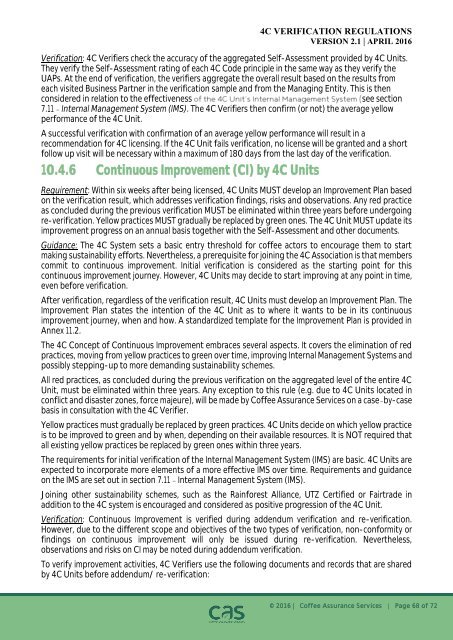VERIFICATION REGULATIONS
2byfvKv
2byfvKv
You also want an ePaper? Increase the reach of your titles
YUMPU automatically turns print PDFs into web optimized ePapers that Google loves.
4C <strong>VERIFICATION</strong> <strong>REGULATIONS</strong><br />
VERSION 2.1 | APRIL 2016<br />
Verification: 4C Verifiers check the accuracy of the aggregated Self-Assessment provided by 4C Units.<br />
They verify the Self-Assessment rating of each 4C Code principle in the same way as they verify the<br />
UAPs. At the end of verification, the verifiers aggregate the overall result based on the results from<br />
each visited Business Partner in the verification sample and from the Managing Entity. This is then<br />
considered in relation to the effectiveness<br />
see section<br />
7.11 Internal Management System (IMS). The 4C Verifiers then confirm (or not) the average yellow<br />
performance of the 4C Unit.<br />
A successful verification with confirmation of an average yellow performance will result in a<br />
recommendation for 4C licensing. If the 4C Unit fails verification, no license will be granted and a short<br />
follow up visit will be necessary within a maximum of 180 days from the last day of the verification.<br />
10.4.6 Continuous Improvement (CI) by 4C Units<br />
Requirement: Within six weeks after being licensed, 4C Units MUST develop an Improvement Plan based<br />
on the verification result, which addresses verification findings, risks and observations. Any red practice<br />
as concluded during the previous verification MUST be eliminated within three years before undergoing<br />
re-verification. Yellow practices MUST gradually be replaced by green ones. The 4C Unit MUST update its<br />
improvement progress on an annual basis together with the Self-Assessment and other documents.<br />
Guidance: The 4C System sets a basic entry threshold for coffee actors to encourage them to start<br />
making sustainability efforts. Nevertheless, a prerequisite for joining the 4C Association is that members<br />
commit to continuous improvement. Initial verification is considered as the starting point for this<br />
continuous improvement journey. However, 4C Units may decide to start improving at any point in time,<br />
even before verification.<br />
After verification, regardless of the verification result, 4C Units must develop an Improvement Plan. The<br />
Improvement Plan states the intention of the 4C Unit as to where it wants to be in its continuous<br />
improvement journey, when and how. A standardized template for the Improvement Plan is provided in<br />
Annex 11.2.<br />
The 4C Concept of Continuous Improvement embraces several aspects. It covers the elimination of red<br />
practices, moving from yellow practices to green over time, improving Internal Management Systems and<br />
possibly stepping-up to more demanding sustainability schemes.<br />
All red practices, as concluded during the previous verification on the aggregated level of the entire 4C<br />
Unit, must be eliminated within three years. Any exception to this rule (e.g. due to 4C Units located in<br />
conflict and disaster zones, force majeure), will be made by Coffee Assurance Services on a case by-case<br />
basis in consultation with the 4C Verifier.<br />
Yellow practices must gradually be replaced by green practices. 4C Units decide on which yellow practice<br />
is to be improved to green and by when, depending on their available resources. It is NOT required that<br />
all existing yellow practices be replaced by green ones within three years.<br />
The requirements for initial verification of the Internal Management System (IMS) are basic. 4C Units are<br />
expected to incorporate more elements of a more effective IMS over time. Requirements and guidance<br />
on the IMS are set out in section 7.11 Internal Management System (IMS).<br />
Joining other sustainability schemes, such as the Rainforest Alliance, UTZ Certified or Fairtrade in<br />
addition to the 4C system is encouraged and considered as positive progression of the 4C Unit.<br />
Verification: Continuous Improvement is verified during addendum verification and re-verification.<br />
However, due to the different scope and objectives of the two types of verification, non-conformity or<br />
findings on continuous improvement will only be issued during re-verification. Nevertheless,<br />
observations and risks on CI may be noted during addendum verification.<br />
To verify improvement activities, 4C Verifiers use the following documents and records that are shared<br />
by 4C Units before addendum/ re-verification:<br />
© 2016 | Coffee Assurance Services | Page 68 of 72


